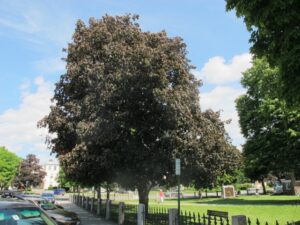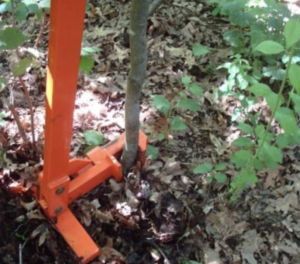New England, with its cold climate, is blessed with a natural defense against some invasives: our winters. But many others have settled in and are taking over – or trying to. It is up to us, the gardeners, to be responsible: we need to learn what the problem plants are, and we need to get rid of any we have growing on our property.
Invasive plants are those that reproduce rapidly and take over wild habitats, out-competing the plants that Mother Nature provided, stealing light, water and nutrients from less aggressive plants. By definition, they are alien species, plants that have come here from other countries. These plants are often very good-looking plants, but thugs.
Most invasives produce large numbers of seeds that are distributed by birds, by the wind, or by water. In most cases, invasives are also difficult to remove or eradicate once established, and have extensive root systems that preclude simply pulling them up.
Back home, in their country of origin, most invasives have predators – insects or diseases – that keep their numbers in check. They may have come inadvertently or been brought by well-intentioned people who thought they were pretty or had some use for them. Some, like burning bush, barberry and Norway maple, have been introduced and sold because they are essentially indestructible – and pretty.
For starters, you can learn to identify the prohibited species in your state, and eliminate them on your own land. Check with your local University Extension service to obtain a list for your state.
Getting rid of invasives, however, may not be easy for two reasons: you may like the invasive species, and may have planted it before you knew better. Secondly, it may not be easy to eliminate – even with the use of herbicides (which you probably don’t want to use anyhow).

‘Crimson King’ Norway maple looks great, but out-competes our native maples in the forest
The Norway maple, for example, is a lovely-looking tree that grows fast and survives well even in urban areas. It will grow in sun or partial shade and is not bothered by road salt. If you have one that is shading your house, I can understand why you might be unwilling to cut it down.
If you are a city dweller, you may assume that since there are no forests nearby, it shouldn’t matter if you keep your Norway maple (or other invasive species). But it’s not just wind or birds that distribute seeds. Runoff can carry seeds to an outlet in a natural environment. Seed from your tree can end up in streams, rivers, ponds. Thus even city dwellers can make a difference, helping to control the propagation of this invasive tree by cutting down theirs.
To see if maple trees growing wild near you are Norway maples, do this simple test: snap off a leaf at its attachment point, and look at the stem. If it oozes a milky sap, it’s a Norway maple. The leaves also tend to be broader and larger than sugar or red maple leaves.
For organic gardeners, getting rid of invasives is not easy. For herbaceous weeds, think lawnmower. Once you have the stalks (and as much of the root mass as possible removed), plant grass seed. Mow it every week and the roots will not be get recharged. Stems will continue to grow for years, but if you mow it, you can win.

There are several brands of weed wrenches that can help to pull small trees and shrubs
Digging the stump of an invasive shrub like barberry, bush honeysuckle or burning bush is a pain in the neck, but you probably can do it. Digging the stump of a large Norway maple is not practical. But there are folks with back hoes and stump grinders, and the expertise to do it.
If your woods are full of small seedlings of invasive trees or shrubs, you may wish to get a tool for pulling saplings called a weed wrench. This tool has a gripping mouth-like part, and a long handle to provide the leverage. A weed wrench of the proper size allows a 150 pound office worker to pull out shrubs and small trees that otherwise would not be possible to yank.
Why bother digging out invasives? You may decide to do it for the sake of your grandchildren, or for the environment. Even in states with good laws prohibiting the sale of invasive plants, no one can force you to cut down or pull out your invasive plants. But being a little selfish is okay, too. Think of all the great plants you can buy and plant if you get rid of those invasives. And think how wonderful it would be if wildflowers and native plants started flourishing in your woods.
Henry Homeyer is an organic
gardener and longtime UNH Master
Gardener. Reach him at
henry.homeyer@comcast.net or PO Box 364, Cornish Flat, NH 03746.




